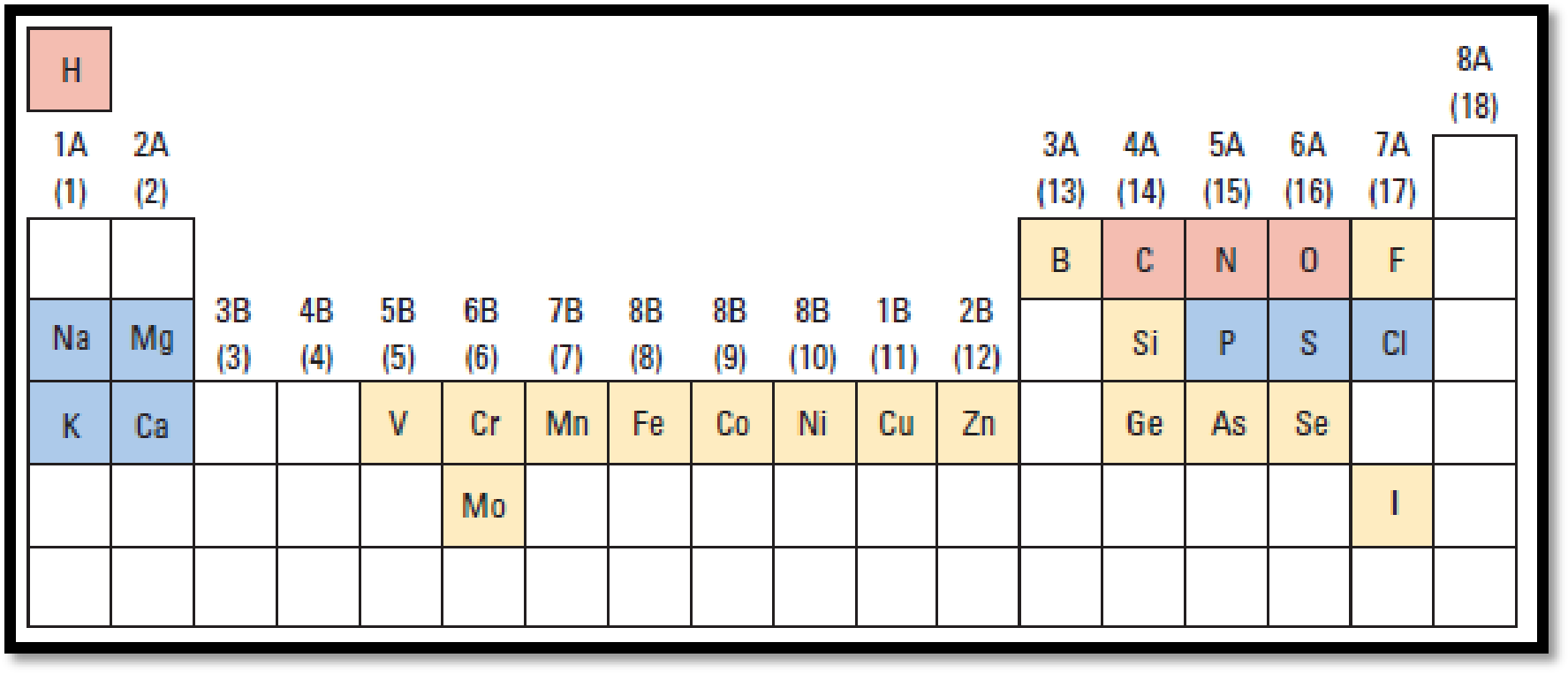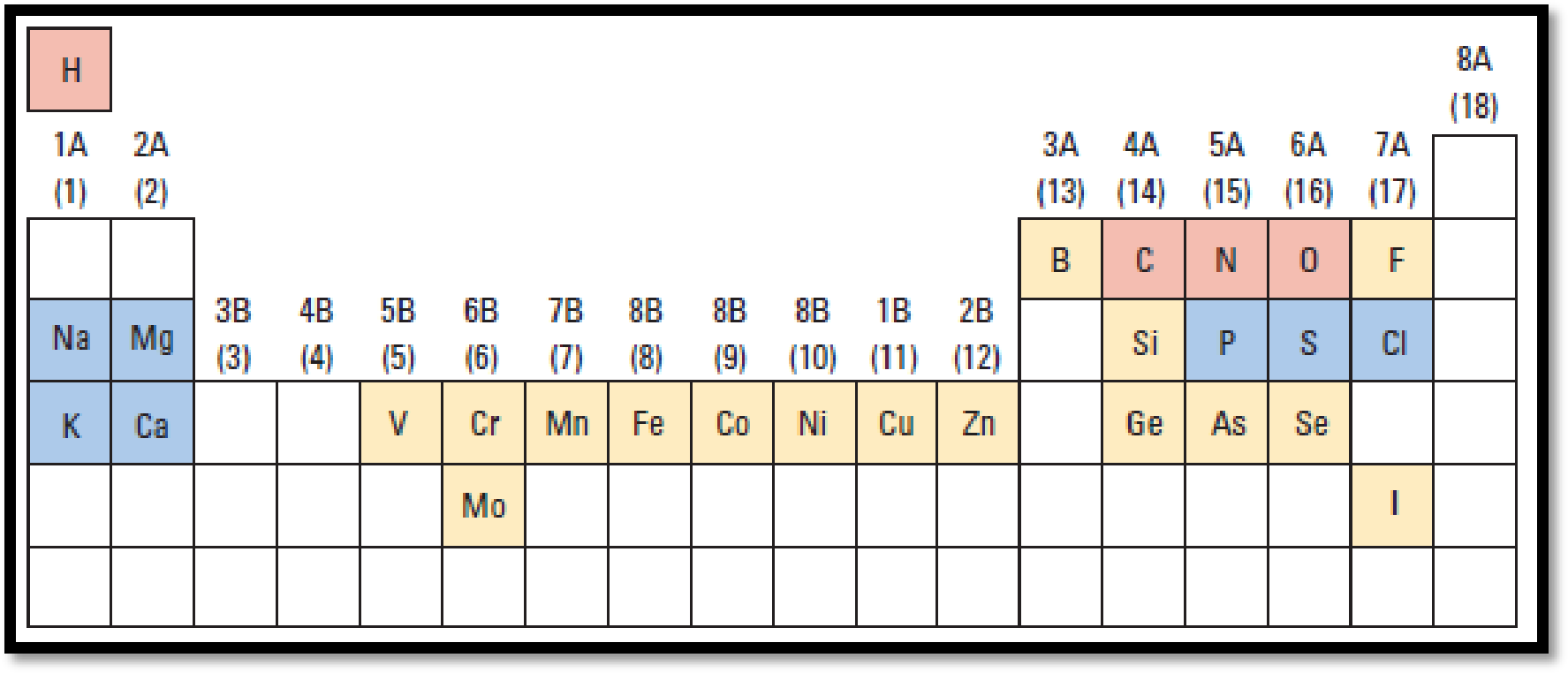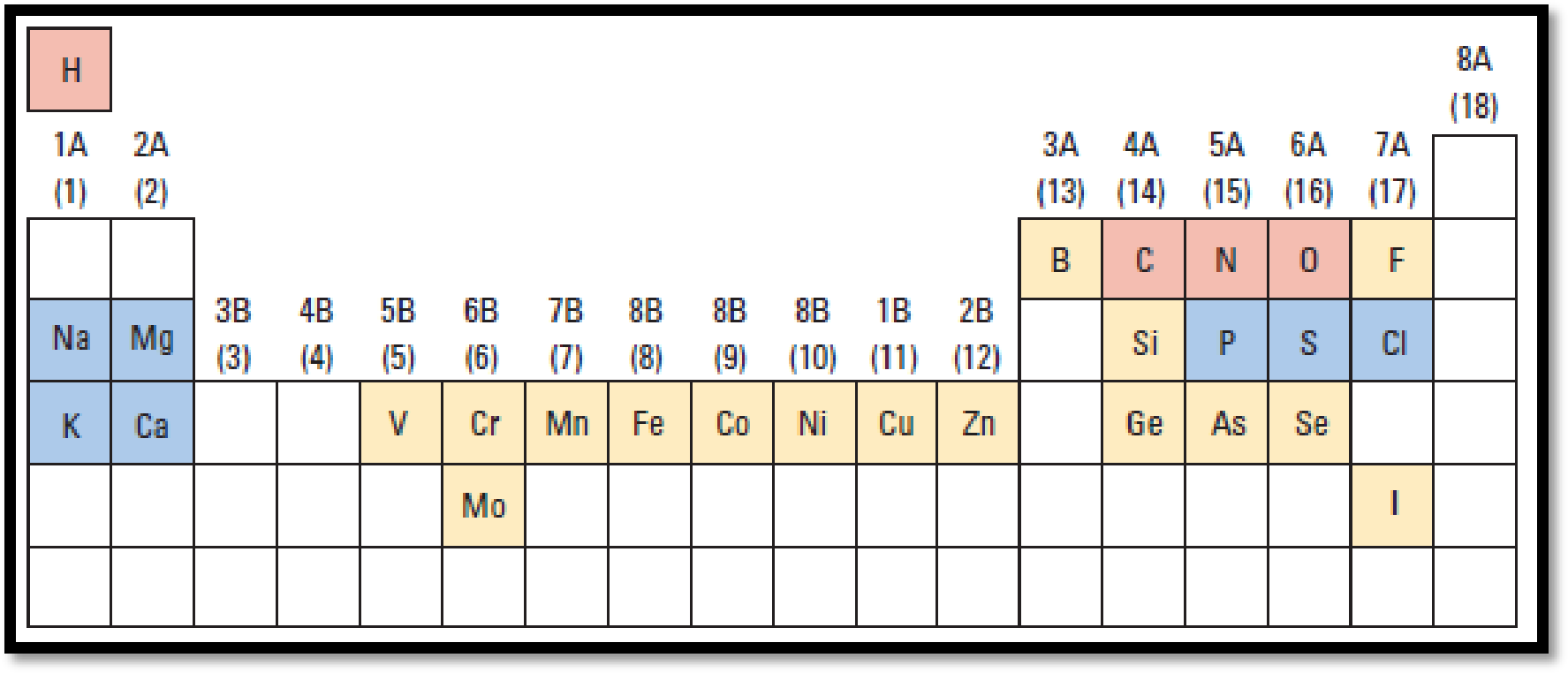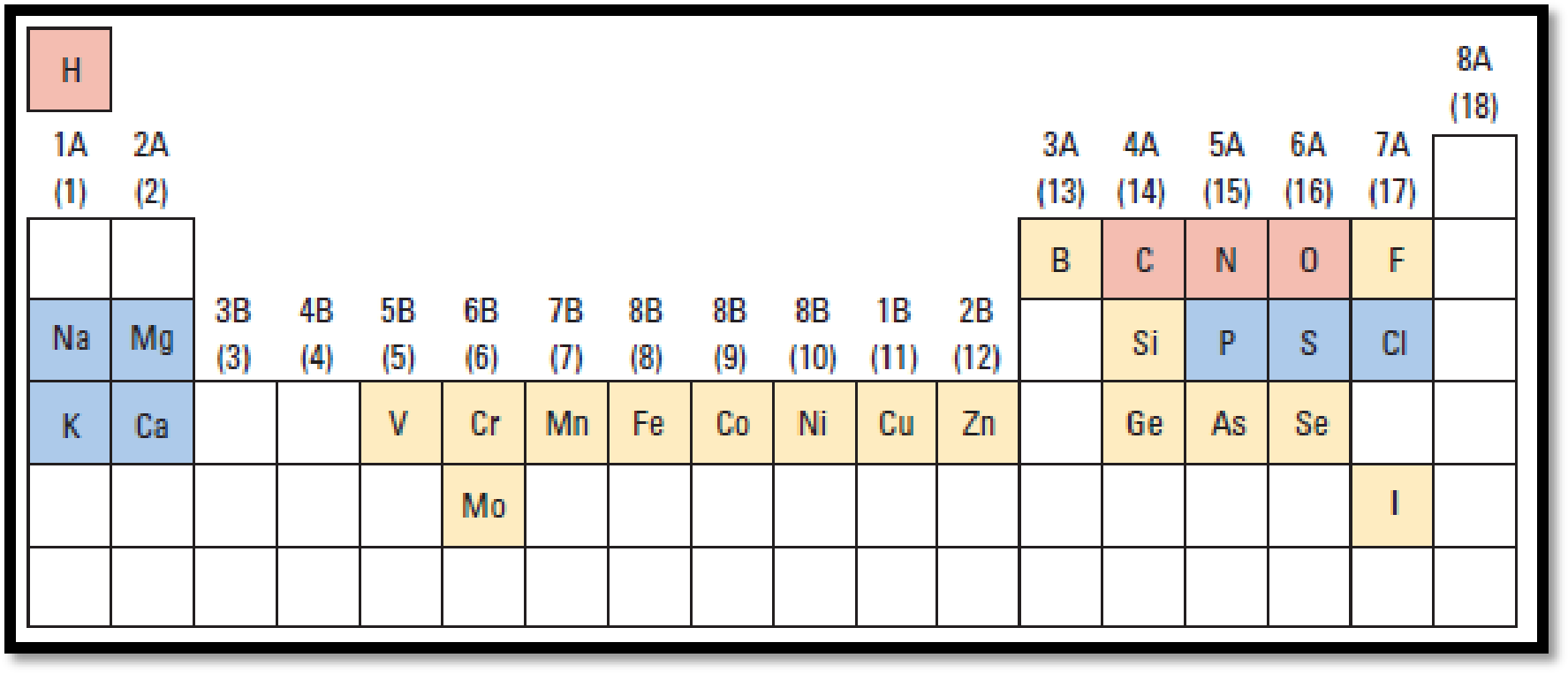
OWLV2 FOR MOORE/STANITSKI'S CHEMISTRY:
5th Edition
ISBN: 9781285460369
Author: STANITSKI
Publisher: Cengage Learning
expand_more
expand_more
format_list_bulleted
Question
Chapter 1.14, Problem 1.13E
(a)
Interpretation Introduction
Interpretation:
Using the given figure, the essential nonmetals has to be identified.

Figure 1
(b)
Interpretation Introduction
Interpretation:
Using the given figure, the essential alkaline-earth metals has to be identified.

Figure 1
(c)
Interpretation Introduction
Interpretation:
Using the given figure, the essential halide ions has to be identified.

Figure 1
(d)
Interpretation Introduction
Interpretation:
Using the given figure, four essential

Figure 1
Expert Solution & Answer
Want to see the full answer?
Check out a sample textbook solution
Students have asked these similar questions
What is the product of the reaction?
F3C.
CF3
OMe
NaOH / H₂O
What is the product of the reaction?
F3C.
CF3
OMe
NaOH / H₂O
What would you expect to be the major product obtained from the following reaction? Please explain what is happening here. Provide a detailed explanation and a drawing showing how the reaction occurs. The correct answer to this question is V.
Chapter 1 Solutions
OWLV2 FOR MOORE/STANITSKI'S CHEMISTRY:
Ch. 1.4 - Temperature
Determine which temperature is higher,...Ch. 1.4 - Prob. 1.2CECh. 1.4 - Identify each physical property and physical...Ch. 1.5 - SI Units and Prefixes
Show mathematically that 1...Ch. 1.5 - Prob. 1.5ECh. 1.5 - Calculate the volume occupied by a 4.33-g sample...Ch. 1.6 - Identify the chemical and physical changes that...Ch. 1.8 - Prob. 1.2PSPCh. 1.8 - Prob. 1.7ECh. 1.9 - Prob. 1.8CE
Ch. 1.11 - Draw a nanoscale representation and a symbolic...Ch. 1.13 - Prob. 1.9ECh. 1.13 - Prob. 1.10ECh. 1.13 - Prob. 1.11ECh. 1.13 - Prob. 1.12ECh. 1.14 - Prob. 1.13ECh. 1 - Prob. 1QRTCh. 1 - Choose an object in your room, such as a cell...Ch. 1 - Prob. 3QRTCh. 1 - Prob. 4QRTCh. 1 - Prob. 5QRTCh. 1 - Prob. 6QRTCh. 1 - Which of these statements are qualitative? Which...Ch. 1 - Which of the these statements are qualitative?...Ch. 1 - The elements sulfur and bromine are shown in the...Ch. 1 - In the accompanying photo, you see a crystal of...Ch. 1 - Prob. 13QRTCh. 1 - Prob. 14QRTCh. 1 - Prob. 15QRTCh. 1 - Suppose a room is 18 m long, 15 m wide, and the...Ch. 1 - Prob. 17QRTCh. 1 - Prob. 18QRTCh. 1 - Prob. 19QRTCh. 1 - Prob. 20QRTCh. 1 - Perform these calculations and express the result...Ch. 1 - Prob. 22QRTCh. 1 - A 105.5-g sample of a metal was placed into water...Ch. 1 - Prob. 24QRTCh. 1 - An unknown sample of a metal is 1.0 cm thick, 2.0...Ch. 1 - Calculate the volume of a 23.4-g sample of...Ch. 1 - Calculate the mass of a sodium chloride crystal if...Ch. 1 - Calculate the volume occupied by a 4.33-g sample...Ch. 1 - In each case, identify the italicized property as...Ch. 1 - Prob. 30QRTCh. 1 - In each case, describe the change as a chemical or...Ch. 1 - In each case, describe the change as a chemical or...Ch. 1 - Prob. 33QRTCh. 1 - Prob. 34QRTCh. 1 - Prob. 35QRTCh. 1 - Identify each of these as a homogeneous or a...Ch. 1 - Devise and describe an experiment to (a) Separate...Ch. 1 - Prob. 38QRTCh. 1 - For each of the changes described, decide whether...Ch. 1 - For each of the changes described, decide whether...Ch. 1 - Classify each of these as an element, a compound,...Ch. 1 - Prob. 42QRTCh. 1 - Prob. 43QRTCh. 1 - Prob. 44QRTCh. 1 - Prob. 45QRTCh. 1 - Prob. 46QRTCh. 1 - Prob. 47QRTCh. 1 - Prob. 48QRTCh. 1 - Prob. 49QRTCh. 1 - Prob. 50QRTCh. 1 - Prob. 51QRTCh. 1 - Prob. 52QRTCh. 1 - Prob. 53QRTCh. 1 - Prob. 54QRTCh. 1 - Write a chemical formula for each substance, and...Ch. 1 - Prob. 56QRTCh. 1 - Prob. 57QRTCh. 1 - Prob. 58QRTCh. 1 - Prob. 59QRTCh. 1 - Prob. 60QRTCh. 1 - Prob. 61QRTCh. 1 - Prob. 62QRTCh. 1 - Name and give symbols for three transition metals...Ch. 1 - Name two halogens. Look up each of your choices in...Ch. 1 - Prob. 65QRTCh. 1 - Prob. 66QRTCh. 1 - Prob. 67QRTCh. 1 - Prob. 68QRTCh. 1 - Prob. 69QRTCh. 1 - Prob. 70QRTCh. 1 - Prob. 71QRTCh. 1 - Prob. 72QRTCh. 1 - Prob. 73QRTCh. 1 - Prob. 74QRTCh. 1 - Prob. 75QRTCh. 1 - Prob. 76QRTCh. 1 - The label on a bale of mulch indicates a volume of...Ch. 1 - Prob. 78QRTCh. 1 - Prob. 79QRTCh. 1 - The cancer drug cisplatin contains 65.0% platinum....Ch. 1 - Prob. 81QRTCh. 1 - The density of gaseous helium at 25 C and normal...Ch. 1 - Prob. 83QRTCh. 1 - Prob. 84QRTCh. 1 - Prob. 85QRTCh. 1 - You can figure out whether a substance floats or...Ch. 1 - Prob. 87QRTCh. 1 - Prob. 88QRTCh. 1 - Prob. 89QRTCh. 1 - Prob. 90QRTCh. 1 - Prob. 91QRTCh. 1 - Which two elements from this list exhibit the...Ch. 1 - Prob. 93QRTCh. 1 - Prob. 94QRTCh. 1 - Prob. 95QRTCh. 1 - Prob. 96QRTCh. 1 - Prob. 97QRTCh. 1 - Prob. 98QRTCh. 1 - Prob. 99QRTCh. 1 - Using Table 1.1, but without using your...Ch. 1 - Prob. 101QRTCh. 1 - At 25 C the density of water is 0.997 g/mL,...Ch. 1 - Prob. 103QRTCh. 1 - Prob. 104QRTCh. 1 - Prob. 105QRTCh. 1 - Prob. 106QRTCh. 1 - Answer these questions using figures (a) through...Ch. 1 - Prob. 108QRTCh. 1 - Prob. 109QRTCh. 1 - Prob. 110QRTCh. 1 - Prob. 111QRTCh. 1 - Prob. 112QRTCh. 1 - Prob. 113QRTCh. 1 - Prob. 114QRTCh. 1 - Prob. 115QRTCh. 1 - Prob. 116QRTCh. 1 - Prob. 118QRTCh. 1 - Prob. 119QRTCh. 1 - Prob. 120QRTCh. 1 - Prob. 121QRTCh. 1 - Prob. 122QRTCh. 1 - The element magnesium reacts with the element...Ch. 1 - Prob. 124QRTCh. 1 - Prob. 125QRTCh. 1 - When 12.6 g calcium carbonate (the principal...Ch. 1 - Prob. 127QRTCh. 1 - Suppose you are trying to get lemon juice and you...Ch. 1 - Prob. 1.BCPCh. 1 - Prob. 1.CCPCh. 1 - Prob. 1.DCPCh. 1 - Prob. 1.ECPCh. 1 - Some scientists think there are living things...Ch. 1 - Prob. 1.GCPCh. 1 - Prob. 1.HCP
Knowledge Booster
Learn more about
Need a deep-dive on the concept behind this application? Look no further. Learn more about this topic, chemistry and related others by exploring similar questions and additional content below.Similar questions
- Please answer the question for the reactions, thank youarrow_forwardWhat is the product of the following reaction? Please include a detailed explanation of what is happening in this question. Include a drawing showing how the reagent is reacting with the catalyst to produce the correct product. The correct answer is IV.arrow_forwardPlease complete the reactions, thank youarrow_forward
- Consider the synthesis. What is compound Y? Please explain what is happening in this question. Provide a detailed explanation and a drawing to show how the compound Y creates the product. The correct answer is D.arrow_forwardWhat would be the major product of the following reaction? Please include a detailed explanation of what is happening in this question. Include steps and a drawing to show this reaction proceeds and how the final product is formed. The correct answer is B. I put answer D and I don't really understand what is going on in the question.arrow_forwardWhat is the product of the following reaction? Please explain what is happening in this question. Provide a detailed explanation and a drawing showing how the reagent is reacting with the catalysts to product the correct product. The correct answer is B.arrow_forward
- What is the missing intermediate 1 and the final product 2. Please include a detailed explanation explaining the steps of malonic ester synthesis. Please include drawings of the intermediate and how it occurs and how the final product is former.arrow_forwardWhat would be the reagents and conditions above and below the arrow that will complete the proposed acetoacetic ester synthesis? If it cannot be done efficiently, then I will choose that answer. There could be 2 or 4 reagents involved. Please provide a detailed explanation and drawings showing how it would proceed with the correct reagents.arrow_forwardFor benzene, the ∆H° of vaporization is 30.72 kJ/mol and the ∆S° of vaporization is 86.97 J/mol・K. At 1.00 atm and 228.0 K, what is the ∆G° of vaporization for benzene, in kJ/mol?arrow_forward
- The reaction Q(g) + R(g) → Z(l) is shown to be exothermic. Which of the following is true concerning the reaction. it is spontaneous only at High T, it is spontaneous at low T it is nonspontaneous at all T it is spontanrous at all T. it is non spontaneous only at low T.arrow_forwardThe reaction Q(g) + R(g) → Z(l) is shown to be exothermic. Which of the following is true concerning the reactionarrow_forwardWhich of the following has the largest standard molar entropy, S° (298.15 K) He H2 NaCl KBr Hgarrow_forward
arrow_back_ios
SEE MORE QUESTIONS
arrow_forward_ios
Recommended textbooks for you

Chemistry
Chemistry
ISBN:9781305957404
Author:Steven S. Zumdahl, Susan A. Zumdahl, Donald J. DeCoste
Publisher:Cengage Learning

What are CHNOPS? These Chemical Elements = 98% of Life | Biology | Biochemistry; Author: Socratica;https://www.youtube.com/watch?v=w90wFlR53VM;License: Standard YouTube License, CC-BY